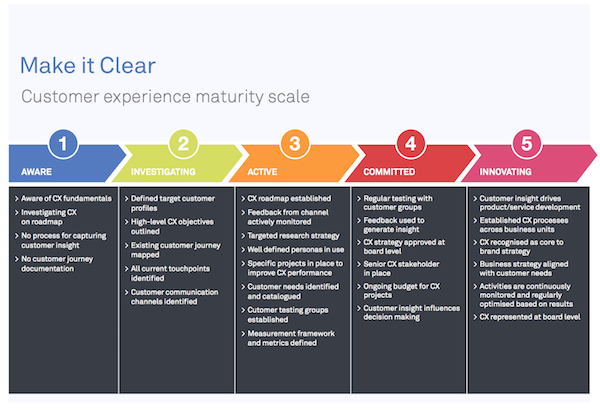CX continues to dominate business media with a corresponding increase in the levels of awareness, knowledge and insight amongst individuals across business sectors. As a consequence there are a lot of highly enjoyable, informative conversations to be had about CX these days, it seems that fellow travellers can be found in every industry.
But the presence of CX practitioners in a wide range of organisations doesn’t tell us how deeply those organisations have embraced CX. So what about the organisations these individuals inhabit? How effective is their CX capability?
When talking about CX maturity we look for an organisations capacity to incorporate, and maintain, a customer-focused approach in their decision making and delivery processes. This capacity can vary significantly, not only by company, but also by department and sometimes by product owner within a business.
Over the years we have developed a pretty effective scale for assessing the maturity of CX within an organisation. It’s not foolproof by any means, but it gives a good guide to what the focus should be for activity to improve or develop CX for our clients.

1. Aware
Organisations at stage one are really at the start of their journey with CX. Likely to be aware of the fundamentals and have an investigation into CX on their roadmap, but they lack processes for capturing customer insight and don’t have good customer journey documentation.
Priorities for an organisation at this stage are in getting a good baseline for where they are now, defining their audience, mapping the existing customer journeys and undertaking a service audit in order to support the creation of CX development strategy.
A good understanding of the current situation makes it much easier to identify and execute relatively small projects focused on demonstrating the value of ROI and supporting wider adoption throughout the business.
2. Investigating
This is perhaps the most common stage we see. Companies have got some decent information, they have targeted profiles for their customers, have high level CX objectives established against an understanding of the existing customer journey and they know where the touchpoints are and what channels support them.
Priorities at this stage are around building that base information into actionable insight, filling in the holes with audience research, audience personas and identifying specific activities that can be undertaken. At this stage it is useful to start thinking about service journeys and the interactions required from different areas of the business within those journeys.
This is the point at which the business can start to achieve quick wins, identifying areas from research and journey reviews that are quick and easy to fix. Keeping track of this is a useful first step in proving the value to the company as a whole.
3. Active
Specific CX projects start to grow in size and profile now, commissioned against an established CX roadmap and measured through feedback channels. A business which is ‘Active’ in CX will have a targeted research strategy, understand their customer personas and be pursuing projects which specifically address CX against identified customer needs. Testing and measurement are done in a structured way.
The activities to support this focus on taking the higher level objectives and CX principles and creating the bridge to them being ‘business as usual’. This is where a lot of the design challenges sit, developing or refining touchpoints, evolving the service design around key journeys, prototyping and usability research; all underpinned by ongoing customer insight and analysis.
The key to maintaining momentum at this stage is visibility of the impact, setting the right KPIs, being disciplined about measuring and highly vocal about outcomes to all levels of the business. The final point helps overcome the inertia of silo’d business systems and structures.
4. Committed
Once the value has been proved, CX inevitably becomes more central to the business. Activities which previously sat as standalone projects become standard practices. For example: regular testing, analysing feedback and using evidence-based methods to create actionable insights, which in turn influence decision making. Within the business, responsibility for CX will reside with a senior stakeholder and budget will be assigned on a committed rather than an ad-hoc basis.
Activities at this stage are more standardised and likely to be executed by internal teams or established partners. Testing, design development, research and the associated generation of insight and analysis are all adopted as regular processes. These run alongside project-specific activities similar to those seen in stage three.
5. Innovating
For practitioners stage five is the aspiration, but for many working within large business it seems unobtainable. Decision making is still driven by logistics and cost, much more than by CX or service design. Our experience working with clients across the earlier stages shows that once the value of a CX-driven approach is established, the business will respond.
Once CX is full integrated it pushes the company into a much more actively innovative posture. Having aligned the strategy that the business pursues and the customer need, customer insight drives product/service development and established CX processes work across functions. Ongoing measurements provide the engine for ongoing optimisation and there is robust support at board level.
Working up the maturity scale may take time, but businesses that actively and genuinely work toward delivering to the needs of their customers will always outperform those that don’t and that simple truth will continue to drive adoption.
Have a call
We’d love to talk to you about how Make it Clear can support your organisation. Book a call here.

